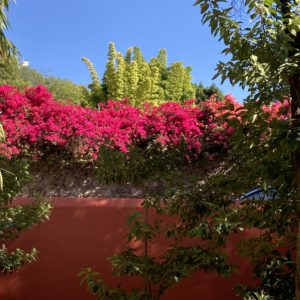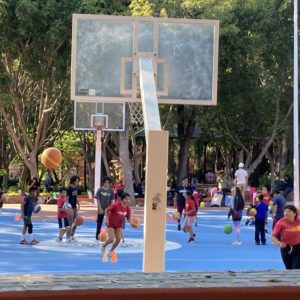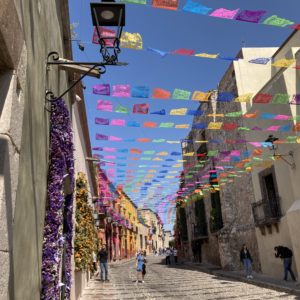From Mexico No. 2
 Our second week in Mexico draws to an end. The colors — des colores — are everywhere so bright and vivid. Of course, the fact that every day, at least so far, is sunny helps. Here’s a photo from a nearby park that shows the orange of a stucco wall, with a little grey of a rock wall topped with bougainvillea, then the yellow-green of trees, possibly bamboo, all under the brightest blue sky.
Our second week in Mexico draws to an end. The colors — des colores — are everywhere so bright and vivid. Of course, the fact that every day, at least so far, is sunny helps. Here’s a photo from a nearby park that shows the orange of a stucco wall, with a little grey of a rock wall topped with bougainvillea, then the yellow-green of trees, possibly bamboo, all under the brightest blue sky.
This park, about two blocks from us, is maybe ten acres. The other day we hung out there, watching the after-school basketball practice of perhaps 60 kids in four different age groups (ages 5 to 15 I’d guess). Each kid has his or her own basketball with clear instructions to be constantly practicing their dribbling if they aren’t at the moment in whatever the particular drill might be.
It’s pretty intense. The coach kept shouting, “andale! andale!” meaning “hurry up, get a move on.” North American negative stereotypes of Mexicans are of laziness and slowness, stereotypes on which Donald Trump played and exacerbated. Not seeing it. Not at all. Not on the basketball court. Not generally. Everybody is working here. I’d say the Mexican work ethic is quite strong. The only people hanging out are the elderly and the tourists, like us. I enjoy sitting on a park bench watching all the activity and life passing by.
 One of the tasks you see people regularly doing is sweeping, even washing down, their section of the sidewalk. Keeping things tidy. And no blowers! Instead of noisy blowers pushing stuff down the block for the next guy, people use brooms and dustbins with long handles to pick stuff up.
One of the tasks you see people regularly doing is sweeping, even washing down, their section of the sidewalk. Keeping things tidy. And no blowers! Instead of noisy blowers pushing stuff down the block for the next guy, people use brooms and dustbins with long handles to pick stuff up.
What you don’t see in the parks are tents, needles and graffiti. Again, this may be because San Miguel de Allende is a popular tourist destination, but it doesn’t feel that’s a complete explanation. It seems that there are community behavioral norms, as well as pride, that keep parks open, usable and attractive.
Still, there are ironies to a place like San Miguel. To some extent, it is supposed to be a “typical Mexican town,” and is even officially designated as such. It is also a UNESCO World Heritage site. But to be these things, that make it attractive as a destination for visitors, both Mexican and international, there is an effort to keep it a little “frozen in time,” so to speak. If it were more modern and the economy more diverse and industrial it wouldn’t qualify as a town typico or be the kind of thing visitors want to see.
 So most of the streets remain cobble stone to preserve the sense of being “a typical Mexican town.” Actually they are not so much shaped or square cobbles as simply rocks embedded in a combination of earth and mortar. You may be able to make that out in my third photo of a pretty “typical” San Miguel street. Flying above the street are the colorful paper cut-outs. You’d think they were for some sort of festival, but it seems that there is something festive going on all the time.
So most of the streets remain cobble stone to preserve the sense of being “a typical Mexican town.” Actually they are not so much shaped or square cobbles as simply rocks embedded in a combination of earth and mortar. You may be able to make that out in my third photo of a pretty “typical” San Miguel street. Flying above the street are the colorful paper cut-outs. You’d think they were for some sort of festival, but it seems that there is something festive going on all the time.
On the other side of the basketball court above there is a gazebo nestled in the trees where two weddings took place the afternoon we were there. Everyone in the wedding party, including all guests, wear white. Each wedding had its own mariachi band and a colorfully decked out donkey, as well as the giant costumed figures of a bride and groom, with someone inside who danced about and who led a procession through the park.
One other thing I notice is that police, who are generally on foot, are quite visible. Again maybe part of making it work for visitors. That said, the police seem more like ordinary people and accessible. They are always in small groups, always men and women. They interact with friends and acquaintance, joking and hugging. They aren’t carrying guns that I can see. In other words, they aren’t menacing, but they are present. At least that’s what I notice.
More to come.
![Anthony B. Robinson [logo]](https://www.anthonybrobinson.com/wp-content/themes/anthonybrobinson/images/logo.png)
![Anthony B. Robinson [logo]](https://www.anthonybrobinson.com/wp-content/themes/anthonybrobinson/images/logo-print.png)